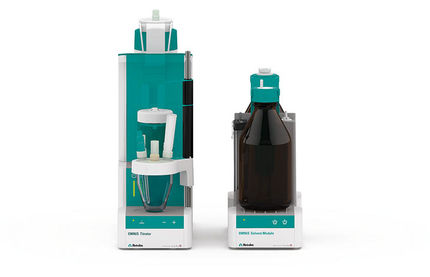| Orange (colour wheel)
|
|
|
| — Colour coordinates —
|
| Hex triplet
| #FF7F00
|
| RGBB
| (r, g, b)
| (255, 127, 0)
|
| HSV
| (h, s, v)
| (30°, 100%, 100%)
|
| Source
| HTML Color Chart @30
|
B: Normalized to [0–255] (byte)
|
The colour orange occurs between red and yellow in the visible spectrum at a wavelength of about 585 – 620 nm, and has a hue of 30° in HSV colour space. The complementary colour of orange is azure, a slightly greenish blue. With pigments such as paints or inks, a mixture of the subtractive primary colours in the proportion of 75% yellow and 25% magenta produce the secondary colour orange. Orange pigments are largely in the ochre or cadmium families, and absorb mostly blue light.
Orange (colour wheel)
At above right is the colour wheel colour orange. This is the colour orange as defined in HSV colour space; that is, it is the hue midway between red and yellow. It is numerically halfway between red and yellow in a gamma-compressed RGB colour space, and is diametrically opposite azure, on the HSV colour wheel.
Etymology of orange
Main article: Orange (word)
The colour is named after the orange fruit, introduced to Europe via the Indo-European word nāranja. Before this was introduced to the English-speaking world, the colour was referred to (in Old English) as geoluhread, which translates into Modern English as yellow-red.
| Orange (web colour)
|
| — Colour coordinates —
|
| Hex triplet
| #FFA500
|
| sRGBB
| (r, g, b)
| (255, 165, 0)
|
| HSV
| (h, s, v)
| (39°, 100%, 100%)
|
| Source
| CSS/X11/SVG[1]
|
B: Normalized to [0–255] (byte)
|
The first recorded use of orange as a colour name in English was in 1512,[2] in the court of King Henry VIII.
Orange web colours
Orange (web colour)
Web colour orange, defined as FFA500, is the only named colour defined in CSS that is not also defined in HTML 4.01
| Dark orange (web colour)
|
| — Colour coordinates —
|
| Hex triplet
| #FF8C00
|
| sRGBB
| (r, g, b)
| (255, 140, 0)
|
| HSV
| (h, s, v)
| (34°, 100%, 100%)
|
| Source
| X11/SVG[1]
|
B: Normalized to [0–255] (byte)
|
Dark orange (web colour)
The web colour called dark orange is displayed at right.
| Orange peel
|
| — Colour coordinates —
|
| Hex triplet
| #FFA000
|
| RGBB
| (r, g, b)
| (255, 160, 0)
|
| HSV
| (h, s, v)
| (38°, 100%, 100%)
|
| Source
| [Unsourced]
|
B: Normalized to [0–255] (byte)
|
Additional variations on the colour orange
Main article: Variations of orange
Orange peel
Displayed at right is the actual colour of the outer skin of a typical orange. This colour is called orange peel. It is the same colour as the fruit for which it was named. In contrast to blue or red, this colour is well determined.
A discussion of the difference between the colours orange and orange peel is given in Maerz and Paul.[3]
The first recorded use of orange peel as a colour name in English was in 1839. [4]
| Tangerine
|
| — Colour coordinates —
|
| Hex triplet
| #F28500
|
| RGBB
| (r, g, b)
| (243, 133, 0)
|
| HSV
| (h, s, v)
| (33°, 100%, 95%)
|
| Source
| BF2S Colour Guide
|
B: Normalized to [0–255] (byte)
|
Tangerine
Main article: Tangerine (color)
At right is the colour tangerine, a shade of orange that is the colour of the tangerine fruit.
The first recorded use of tangerine as a colour name in English was in 1899. [5]
| Carrot orange
|
| — Colour coordinates —
|
| Hex triplet
| #ED9121
|
| RGBB
| (r, g, b)
| (237, 145, 33)
|
| HSV
| (h, s, v)
| (33°, 86%, 93%)
|
| Source
| [Unsourced]
|
B: Normalized to [0–255] (byte)
|
Carrot orange
Carrot orange is a tint of orange that is the colour of the raw carrot vegetable.
The first recorded use of carrot orange as a colour name in English was in 1684. [6]
| Burnt orange
|
| — Colour coordinates —
|
| Hex triplet
| #CC5500
|
| RGBB
| (r, g, b)
| (204, 85, 0)
|
| HSV
| (h, s, v)
| (25°, 100%, 80%)
|
| Source
| BF2S Colour Guide
|
B: Normalized to [0–255] (byte)
|
Burnt orange
Burnt orange has been in use as a colour name for this deep shade of orange since 1915. [7]
This colour is one variation that is used as a school colour of the Clemson University, Virginia Tech, Auburn University, and The University of Texas at Austin.
Burnt Orange was popular in interior design in the 1970s.
So-called redheads actually have hair that averages a burnt orange colour.
| Brown
|
| — Colour coordinates —
|
| Hex triplet
| #964B00
|
| RGBB
| (r, g, b)
| (150, 75, 0)
|
| HSV
| (h, s, v)
| (30°, 100%, 59%)
|
| Source
| BF2S Colour Guide
|
B: Normalized to [0–255] (byte)
|
Brown
Main article: Brown
Brown is actually derived from the orange part (orange + grey) of the colour spectrum. It can be described as dark orange.
The first recorded use of brown as a colour name in English was in 1000. [8]
Orange in human culture
Academia
- In the United States, orange regalia is associated with the field of engineering.
Cosmetology
- People whose natural hair colour is metaphorically described in English as being red, i.e. redheads, actually have hair that averages a burnt orange colour.
Geography and history
- Orange is the national colour of The Netherlands, because its royal family used to own the principality of Orange (the title is still used for the Dutch heir apparent). There is no etymological connection between orange (the fruit and colour) and Orange (the name of the principality), and the similarity is fortuitous.[citation needed] Orange is the colour of choice for many of the national sports teams and their supporters. The nickname of the Dutch national football team is Oranje, the Dutch word for orange. In the modern flag of the Netherlands, red substitutes the original orange, but on royal birthdays, the flag has an additional orange banner. Most geographical usages of the word orange can be traced back to Dutch maritime power in the 17th century.
- In Ireland the use of orange dates from the reign of William of Orange, the Protestant English king and a Dutch stadholder.
Heraldry
- In English heraldry, orange is considered synonymous with the tincture tenne. However, its use as a heraldic tincture is relatively rare, as it is considered a "stain" (a deprecated tincture) by some. In continental heraldry, tenne is more often deemed to denote a burnt orange colour.
Holidays
- The colours orange and black represent the holiday Halloween (31 October) because orange is the colour of pumpkins and black is the colour of night and is associated with doom, despair and darkness.
- The colours orange and brown represent the United States holiday Thanksgiving.
Military
- In the United States Army, orange is the colour of the United States Army Signal Corps.
National colours
- Orange is the national colour of the Netherlands and is seen on its original flag and coat of arms.
- Orange, white, and green are the national colours of Ireland, Niger, and Côte d'Ivoire.
Mysticism
- In the metaphysics of the New Age Prophetess, Alice A. Bailey, in her system called the Seven Rays which classifies humans into seven different metaphysical personality types, the fifth ray of concrete science is represented by the colour orange. People who have this metaphysical personality type are said to be on the Orange Ray.
- Orange is used to symbolically represent the second (Swadhisthana) chakra.
- Psychics who claim to be able to observe the aura with their third eye report that an orange aura is associated with intellectual ambition.[9]
Ophthalmology
- A woman named Susan Hogan was born with an extra set of cones that are sensitive in the orange range, as well having the red, green, and blue cones that humans with normal colour vision (i.e. trichromats) possess. She is therefore classified as a tetrachromat, but her extra type of cone is an orange cone instead of the ultraviolet cone possessed by animals such as birds who are tetrachromats in nature. It is estimated that while normal humans can see about 1,000,000 different colours, tetrachromats such as Ms. Hogan can see 100,000,000 different colours. This is because each additional type of cones reacts with the other types of cones in such a way that an addition of a new type of cone means an organism can see 100 times as many colours. (This means that a pentachromat would be able to see 10,000,000,000 (ten billion) different colours.) [10]
Penology
- Prisoners incarcerated in many American jails and prisons are made to wear orange jumpsuits so they will be easy to see if they try to escape.
Politics
- Orange was the rallying colour of the 2004 – 2005 Orange Revolution in Ukraine and has thus become a colour symbolising opposition to tyranny around the world.
- Orange is sometimes associated with various Christian democratic and populist parties.
- Orange was used as a rallying colour by Israelis (such as Jewish settlers) who opposed Israel's unilateral disengagement plan in the Gaza Strip and the West Bank in 2005
- Unionism in Ireland is associated with orange, due to its Protestant symbolism and connection to William of Orange (William III of England)
- Orange is the party colour of:
- Orange Democratic Movement, Kenya
- Fidesz – Hungarian Civic Union (Fidesz-MPSZ) in Hungary
- Christian Democratic and Flemish (CD&V), Flanders, Belgium
- People's National Party, Jamaica
- Justice and Truth Alliance, Romania
- People First Party, Republic of China (Taiwan)
- New Democratic Party, Canada
- June List, Sweden
- Free Patriotic Movement, Lebanon
- Bharatiya Janata Party (BJP), India
- PORA, Ukraine - see Orange Revolution
- Social Democratic Party, Portugal
- People's Party (Spain) since 2005
- Alliance for the Future of Austria (BZÖ), Jörg Haider's newly formed party in Austria
- National Union (Israel)
- Reformed Political Party, Netherlands
- Christian Democratic Union, Germany
- Union for French Democracy and Democratic Movement, France
- Democratic Party, Italy
- European Democratic Party
Prosody
- Orange is often quoted (along with Purple and Silver (color)) as a word that doesn't rhyme with any other word in the English language. This is debatable - see Orange (word)#Rhyme
However, the Oxford Rhyming Dictionary does show both these words as having half-rhymes (such as lozenge with orange and salver with silver).
In a children's book of verse, in a poem titled "Color," there are these lines:
What is red? a poppy's red, in its barley bed.
What is orange? Why, an orange--just an orange!
Raves
- Orange is the favorite colour for people to wear to rave dances.[citation needed]
Religion
- Orange signifies Protestantism in Northern Ireland (see Orange Institution) and to a lesser extent in the Republic of Ireland (the orange part of whose flag represents the Protestant population) [11])
- Orange in general represents Hinduism in the flags of India and Sri Lanka. Hindu gurus usually wear orange robes. In actuality, the specific shade of orange that represents Hinduism on the Indian National Flag is officially called deep saffron.
Safety Signalling
- Orange is the contrasting colour of blue and is highly visible against a clear sky. Therefore, shades of orange such as safety orange are often used in high visibility clothing and other safety equipment and objects.
Security
- The U.S. Department of Homeland Security's code orange on its terror threat scale represents a high risk, second highest to severe.
Sport
- Orange is (usually) the colour of the Netherlands national football team and all other Dutch national teams and athletes.
- Orange is also the colour of the Ivory Coast national football team.
- In American collegiate athletics, orange is combined with other colours to form the colours for:
- Auburn University
- Boise State University
- Bowling Green State University
- Campbell University
- Clemson University
- Oklahoma State University
- Oregon State University
- Princeton University
- The Rochester Institute of Technology
- Sam Houston State University
- The University of Illinois
- The University of Florida
- The University of Miami
- The University of the Pacific
- The University of Virginia
- University of Tennessee
- The University of Texas
- The University of Texas at El Paso
- Virginia Polytechnic Institute and State University
- The Orange is the name of several sports teams at Syracuse, in addition to being the university's colour.
- American professional teams that use orange as a primary colour include the Baltimore Orioles, San Francisco Giants and New York Mets of Major League Baseball, the Chicago Bears, Cleveland Browns, Cincinnati Bengals, Denver Broncos, and Miami Dolphins of the National Football League, the New York Knicks, the Phoenix Suns and the Charlotte Bobcats of the National Basketball Association and the Philadelphia Flyers and New York Islanders of the National Hockey League.
- Orange is the colour of the second equipation of Valencia CF (Spain). The Land of Valencia has oranges as a traditional produce.
- Orange is the colour of Blackpool FC in England
- Orange is also the colour of J-league football team, Omiya Ardija.
- Finnish SM-Liiga ice-hockey team Tappara is famous for unusual orange hockey pants.
- Orange is the traditional and most common colour of a Basketball.
- Orange is the colour of the 5-ball and 13-ball in Billiards. (The 13-ball is white with an orange stripe.)
- Orange is the colour of the ball in Snooker Plus with an 8-point value.
Transportation
- Deluxe International orange is the colour of the paint on San Francisco's Golden Gate Bridge
- The U.S. Manual on Uniform Traffic Control Devices specifies orange for use in temporary and construction signage.
References
- ^ a b W3C TR CSS3 Color Module, HTML4 color keywords
- ^ Maerz and Paul A Dictionary of Color New York:1930 McGraw-Hill Page 200
- ^ Maerz and Paul A Dictionary of Color New York:1930--McGraw-Hill--Discussion of color Orange, Page 170
- ^ Maerz and Paul A Dictionary of Color New York:1930 McGraw-Hill Page 200; Color Sample: Orange Peel Page 43 Plate 10 Color Sample L10.
- ^ Maerz and Paul A Dictionary of Color New York:1930 McGraw-Hill Page 205; Color Sample: Tangerine Page 27 Plate 2 Color Sample H11
- ^ Maerz and Paul A Dictionary of Color New York:1930 McGraw-Hill Page 192; Color Sample: Carrot Orange Page 43 Plate 10 Color Sample C11; see discussion of color "carrot orange" on page 152.
- ^ Maerz and Paul A Dictionary of Color New York: 1930--McGraw-Hill Page 191 ; Color sample of Burnt Orange: Page 29 Plate 3 Color Sample E12
- ^ Maerz and Paul A Dictionary of Color New York:1930 McGraw-Hill Page 191
- ^ Swami Panchadasi The Human Aura: Astral Colors and Thought Forms Des Plaines, Illinois, USA:1912--Yogi Publications Society Page 33
- ^ Some women may see 100,000,000 colors, thanks to their genes (Article by Mark Roth in the Philadelphia Post-Gazette Wednesday, September 13, 2006):
- ^ Irel=and's Washington DC Embassy webpage Accessed June 4, 2007.
See also
- Amber
- List of colours
- Tangerine
| The Heraldic Tincture Series |
|---|
| Rule of Tincture | | Metals | Argent · Or |
|---|
| Colours | Azure · Gules · Purpure · Sable · Vert |
|---|
| Furs | Ermine · Vair · Potent |
|---|
| Stains | Murrey · Tenné · Sanguine |
|---|
| Other | Bleu celeste · Carnation · Cendrée · Orange |
|---|
| v • d • e Web colours
|
| black
| gray
| silver
| white
| red
| maroon
| purple
| fuchsia
| green
| lime
| olive
| yellow
| gold
| orange
| blue
| navy
| teal
| aqua
|
|
|
|
|
|
|
|
|
|
|
|
|
|
|
|
|
|
|
|
|







